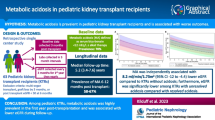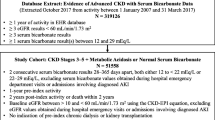Abstract
Background
Metabolic acidosis is an independent risk factor for kidney disease progression with a high prevalence after kidney transplantation (KTx). Remarkably, it is still unclear if there is an impact of metabolic acidosis on graft function and death after KTx. Thus, we wanted to investigate if serum bicarbonate is associated with long-term graft outcome and mortality after KTx.
Methods
We performed a single-center retrospective study including adult de novo KTx patients between 1999 and 2015. Cox proportional hazard model was used to analyze a possible association between time-dependent serum bicarbonate measurements and graft failure or death.
Results
Four hundred thirty KTRs were included in the analysis with a mean age of 50.9 ± 13.4 years. Mean observation time was 4.7 ± 2.8 years. Two hundred eighty-four (66%) patients were male and 318 (74%) had received a deceased donor kidney transplant. Mean bicarbonate and eGFR levels 1 year post-transplant amounted to 22.9 ± 3.1 mEq/L and 61 ± 26 ml/min/1.73 m2, respectively. Prevalence of metabolic acidosis was 31% 1 year after transplantation. Fourteen (3%) patients died and 31 (7%) suffered from graft failure. Higher bicarbonate levels were associated with significantly lower hazards for graft failure (Hazard Ratio (HR) = 0.88; 95% Confidence Interval (CI): 0.79–0.98) and mortality (HR = 0.79; 95% CI 0.66–0.93) after adjusting for potential confounders such as age, donor type and time-varying eGFR.
Conclusions
Our analysis showed that higher serum bicarbonate levels are positively associated with long-term graft and patient survival in kidney transplant recipients. Thus, serum bicarbonate may serve as a predictor and independent risk factor for graft and patient outcome after KTx as has been previously shown for patients with CKD.
Graphical abstract





Similar content being viewed by others
References
Santos J, Martins LS (2015) Estimating glomerular filtration rate in kidney transplantation: Still searching for the best marker. World J Nephrol 4(3):345–353
Matas AJ, Smith JM, Skeans MA et al (2014) OPTN/SRTR 2012 Annual Data Report: kidney. Am J Transplant 14(Suppl 1):11–44
Swiss Transplant Cohort Study-Output Data 2018. http://www.stcs.ch/documents2018. Accessed July 2021
Stegall MD, Cornell LD, Park WD, Smith BH, Cosio FG (2018) Renal allograft histology at 10 years after transplantation in the tacrolimus era: evidence of pervasive chronic injury. Am J Transplant 18(1):180–188
Inker LA, Coresh J, Levey AS, Tonelli M, Muntner P (2011) Estimated GFR, albuminuria, and complications of chronic kidney disease. J Am Soc Nephrol 22(12):2322–2331
Franke D, Thomas L, Steffens R et al (2015) Patterns of growth after kidney transplantation among children with ESRD. Clin J Am Soc Nephrol 10(1):127–134
Pickering WP, Price SR, Bircher G, Marinovic AC, Mitch WE, Walls J (2002) Nutrition in CAPD: serum bicarbonate and the ubiquitin-proteasome system in muscle. Kidney Int 61(4):1286–1292
Kraut JA (2000) Disturbances of acid-base balance and bone disease in end-stage renal disease. Semin Dial 13(4):261–266
de Brito-Ashurst I, Varagunam M, Raftery MJ, Yaqoob MM (2009) Bicarbonate supplementation slows progression of CKD and improves nutritional status. J Am Soc Nephrol 20(9):2075–2084
Mahajan A, Simoni J, Sheather SJ, Broglio KR, Rajab MH, Wesson DE (2010) Daily oral sodium bicarbonate preserves glomerular filtration rate by slowing its decline in early hypertensive nephropathy. Kidney Int 78(3):303–309
Kovesdy CP, Anderson JE, Kalantar-Zadeh K (2009) Association of serum bicarbonate levels with mortality in patients with non-dialysis-dependent CKD. Nephrol Dial Transplant 24(4):1232–1237
Kraut JA, Madias NE (2016) Metabolic acidosis of CKD: an update. Am J Kidney Dis 67(2):307–317
Driver TH, Shlipak MG, Katz R et al (2014) Low serum bicarbonate and kidney function decline: the Multi-Ethnic Study of Atherosclerosis (MESA). Am J Kidney Dis 64(4):534–541
Goldenstein L, Driver TH, Fried LF et al (2014) Serum bicarbonate concentrations and kidney disease progression in community-living elders: the Health, Aging, and Body Composition (Health ABC) Study. Am J Kidney Dis 64(4):542–549
Phisitkul S, Khanna A, Simoni J et al (2010) Amelioration of metabolic acidosis in patients with low GFR reduced kidney endothelin production and kidney injury, and better preserved GFR. Kidney Int 77(7):617–623
Raphael KL, Zhang Y, Wei G, Greene T, Cheung AK, Beddhu S (2013) Serum bicarbonate and mortality in adults in NHANES III. Nephrol Dial Transplant 28(5):1207–1213
Navaneethan SD, Schold JD, Arrigain S et al (2011) Serum bicarbonate and mortality in stage 3 and stage 4 chronic kidney disease. Clin J Am Soc Nephrol 6(10):2395–2402
Messa PG, Alfieri C, Vettoretti S (2016) Metabolic acidosis in renal transplantation: neglected but of potential clinical relevance. Nephrol Dial Transplant 31(5):730–736
Mohebbi N, Mihailova M, Wagner CA (2009) The calcineurin inhibitor FK506 (tacrolimus) is associated with transient metabolic acidosis and altered expression of renal acid-base transport proteins. Am J Physiol Renal Physiol 297(2):F499-509
Keven K, Ozturk R, Sengul S et al (2007) Renal tubular acidosis after kidney transplantation–incidence, risk factors and clinical implications. Nephrol Dial Transplant 22(3):906–910
Kocyigit I, Unal A, Kavuncuoglu F et al (2010) Renal tubular acidosis in renal transplantation recipients. Ren Fail 32(6):687–690
Djamali A, Singh T, Melamed ML et al (2019) Metabolic acidosis 1 year following kidney transplantation and subsequent cardiovascular events and mortality: an observational cohort study. Am J Kidney Dis 73(4):476–485
Park S, Kang E, Park S et al (2017) Metabolic acidosis and long-term clinical outcomes in kidney transplant recipients. J Am Soc Nephrol 28(6):1886–1897
Brazier F, Jouffroy J, Martinez F et al (2020) Association of blood bicarbonate and pH with mineral metabolism disturbance and outcome after kidney transplantation. Am J Transplant 20(4):1063–1075
Schulte K, Püchel J, Schüssel K, Borzikowsky C, Kunzendorf U, Feldkamp T (2019) Effect of sodium bicarbonate in kidney transplant recipients with chronic metabolic acidosis. Transplant Direct. 5(7):e464
Levey AS, Stevens LA, Schmid CH et al (2009) A new equation to estimate glomerular filtration rate. Ann Intern Med 150(9):604–612
Navaneethan SD, Shao J, Buysse J, Bushinsky DA (2019) Effects of treatment of metabolic acidosis in CKD: a systematic review and meta-analysis. Clin J Am Soc Nephrol 14(7):1011–1020
Raphael KL, Wei G, Baird BC, Greene T, Beddhu S (2011) Higher serum bicarbonate levels within the normal range are associated with better survival and renal outcomes in African Americans. Kidney Int 79(3):356–362
Goraya N, Simoni J, Jo CH, Wesson DE (2014) Treatment of metabolic acidosis in patients with stage 3 chronic kidney disease with fruits and vegetables or oral bicarbonate reduces urine angiotensinogen and preserves glomerular filtration rate. Kidney Int 86(5):1031–1038
Chapter 3: Management of progression and complications of CKD (2013) Kidney Int Suppl. 3(1): 73–90.
Wiegand A, Ritter A, Graf N et al (2018) Preservation of kidney function in kidney transplant recipients by alkali therapy (Preserve-Transplant Study): rationale and study protocol. BMC Nephrol 19(1):177
Wesson DE (2021) The continuum of acid stress. Clin J Am Soc Nephrol 16(8):1292–1299
Prot-Bertoye C, Vallet M, Houillier P (2021) Monitoring acid base status in CKD patients: can urinary citrate help? Kidney Int 99(1):28–31
Kraut JA, Raphael KL (2021) Assessment of acid-base status: beyond serum bicarbonate. Clin J Am Soc Nephrol 16(9):1429–1431
Gomes-Neto AW, Oste MC, Sotomayor CG et al (2020) Mediterranean style diet and kidney function loss in kidney transplant recipients. Clin J Am Soc Nephrol 15(2):238–246
Yusof Said M, Rodriguez-Nino A, Post A et al (2021) Meat intake and risk of mortality and graft failure in kidney transplant recipients. Am J Clin Nutr 00:1–13
Funding
No funding was received for this project.
Author information
Authors and Affiliations
Contributions
Research idea and design: AW, LH, NM, SFL; data acquisition: AW, SVM; statistical analysis: AW, LH, SFL; data interpretation: AW, LH, NM, SFL; manuscript preparation: AW, LH, NM, RPW, SFL, SVM.
Each author contributed important intellectual content during manuscript drafting or revision, accepts personal accountability for the author’s own contributions, and agrees to ensure that questions pertaining to the accuracy or integrity of any portion of the work are appropriately investigated and resolved.
Corresponding author
Ethics declarations
Conflict of interest
All authors declare no conflicts of interest. We confirm that the results presented in this paper have not been published previously in whole or part, except in abstract form.
Additional information
Publisher's Note
Springer Nature remains neutral with regard to jurisdictional claims in published maps and institutional affiliations.
Supplementary Information
Below is the link to the electronic supplementary material.
Rights and permissions
About this article
Cite this article
Wiegand, A., Lim, S.F., von Moos, S. et al. Association of serum bicarbonate with graft survival and mortality in kidney transplant recipients. J Nephrol 35, 619–627 (2022). https://doi.org/10.1007/s40620-021-01197-6
Received:
Accepted:
Published:
Issue Date:
DOI: https://doi.org/10.1007/s40620-021-01197-6




